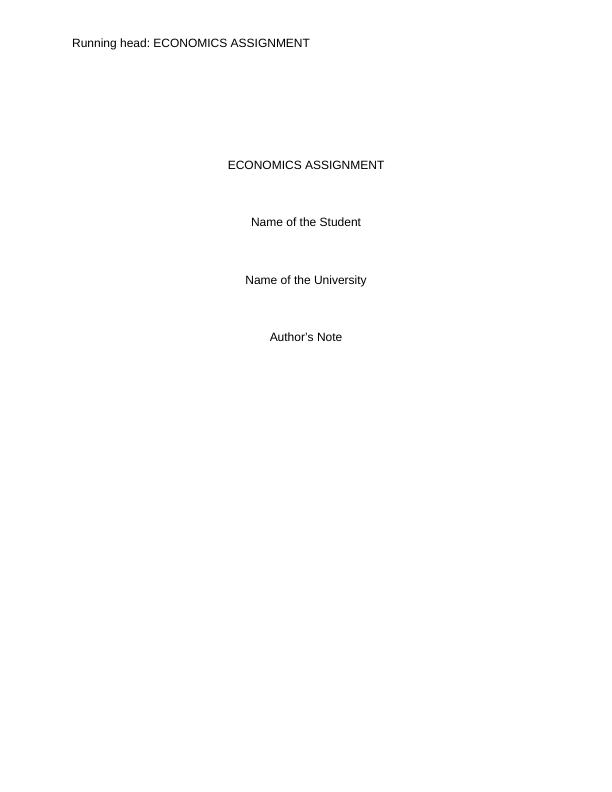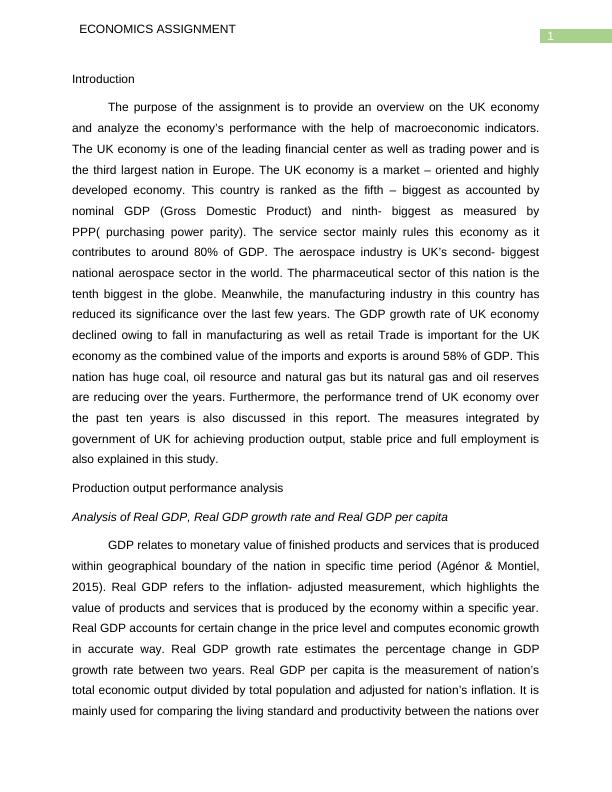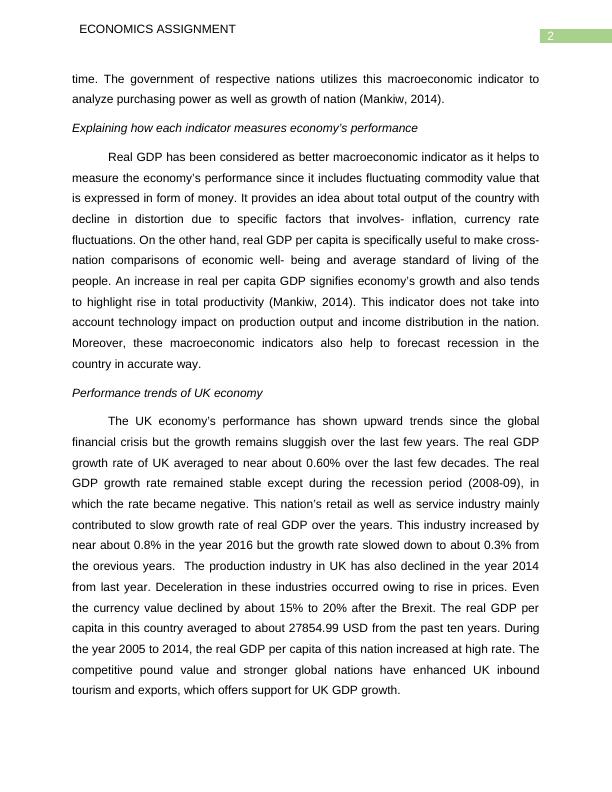Analyzing UK Economy's Performance with Macroeconomic Indicators
Added on 2023-06-10
10 Pages2761 Words371 Views
Running head: ECONOMICS ASSIGNMENT
ECONOMICS ASSIGNMENT
Name of the Student
Name of the University
Author’s Note
ECONOMICS ASSIGNMENT
Name of the Student
Name of the University
Author’s Note

1
ECONOMICS ASSIGNMENT
Introduction
The purpose of the assignment is to provide an overview on the UK economy
and analyze the economy’s performance with the help of macroeconomic indicators.
The UK economy is one of the leading financial center as well as trading power and is
the third largest nation in Europe. The UK economy is a market – oriented and highly
developed economy. This country is ranked as the fifth – biggest as accounted by
nominal GDP (Gross Domestic Product) and ninth- biggest as measured by
PPP( purchasing power parity). The service sector mainly rules this economy as it
contributes to around 80% of GDP. The aerospace industry is UK’s second- biggest
national aerospace sector in the world. The pharmaceutical sector of this nation is the
tenth biggest in the globe. Meanwhile, the manufacturing industry in this country has
reduced its significance over the last few years. The GDP growth rate of UK economy
declined owing to fall in manufacturing as well as retail Trade is important for the UK
economy as the combined value of the imports and exports is around 58% of GDP. This
nation has huge coal, oil resource and natural gas but its natural gas and oil reserves
are reducing over the years. Furthermore, the performance trend of UK economy over
the past ten years is also discussed in this report. The measures integrated by
government of UK for achieving production output, stable price and full employment is
also explained in this study.
Production output performance analysis
Analysis of Real GDP, Real GDP growth rate and Real GDP per capita
GDP relates to monetary value of finished products and services that is produced
within geographical boundary of the nation in specific time period (Agénor & Montiel,
2015). Real GDP refers to the inflation- adjusted measurement, which highlights the
value of products and services that is produced by the economy within a specific year.
Real GDP accounts for certain change in the price level and computes economic growth
in accurate way. Real GDP growth rate estimates the percentage change in GDP
growth rate between two years. Real GDP per capita is the measurement of nation’s
total economic output divided by total population and adjusted for nation’s inflation. It is
mainly used for comparing the living standard and productivity between the nations over
ECONOMICS ASSIGNMENT
Introduction
The purpose of the assignment is to provide an overview on the UK economy
and analyze the economy’s performance with the help of macroeconomic indicators.
The UK economy is one of the leading financial center as well as trading power and is
the third largest nation in Europe. The UK economy is a market – oriented and highly
developed economy. This country is ranked as the fifth – biggest as accounted by
nominal GDP (Gross Domestic Product) and ninth- biggest as measured by
PPP( purchasing power parity). The service sector mainly rules this economy as it
contributes to around 80% of GDP. The aerospace industry is UK’s second- biggest
national aerospace sector in the world. The pharmaceutical sector of this nation is the
tenth biggest in the globe. Meanwhile, the manufacturing industry in this country has
reduced its significance over the last few years. The GDP growth rate of UK economy
declined owing to fall in manufacturing as well as retail Trade is important for the UK
economy as the combined value of the imports and exports is around 58% of GDP. This
nation has huge coal, oil resource and natural gas but its natural gas and oil reserves
are reducing over the years. Furthermore, the performance trend of UK economy over
the past ten years is also discussed in this report. The measures integrated by
government of UK for achieving production output, stable price and full employment is
also explained in this study.
Production output performance analysis
Analysis of Real GDP, Real GDP growth rate and Real GDP per capita
GDP relates to monetary value of finished products and services that is produced
within geographical boundary of the nation in specific time period (Agénor & Montiel,
2015). Real GDP refers to the inflation- adjusted measurement, which highlights the
value of products and services that is produced by the economy within a specific year.
Real GDP accounts for certain change in the price level and computes economic growth
in accurate way. Real GDP growth rate estimates the percentage change in GDP
growth rate between two years. Real GDP per capita is the measurement of nation’s
total economic output divided by total population and adjusted for nation’s inflation. It is
mainly used for comparing the living standard and productivity between the nations over

2
ECONOMICS ASSIGNMENT
time. The government of respective nations utilizes this macroeconomic indicator to
analyze purchasing power as well as growth of nation (Mankiw, 2014).
Explaining how each indicator measures economy’s performance
Real GDP has been considered as better macroeconomic indicator as it helps to
measure the economy’s performance since it includes fluctuating commodity value that
is expressed in form of money. It provides an idea about total output of the country with
decline in distortion due to specific factors that involves- inflation, currency rate
fluctuations. On the other hand, real GDP per capita is specifically useful to make cross-
nation comparisons of economic well- being and average standard of living of the
people. An increase in real per capita GDP signifies economy’s growth and also tends
to highlight rise in total productivity (Mankiw, 2014). This indicator does not take into
account technology impact on production output and income distribution in the nation.
Moreover, these macroeconomic indicators also help to forecast recession in the
country in accurate way.
Performance trends of UK economy
The UK economy’s performance has shown upward trends since the global
financial crisis but the growth remains sluggish over the last few years. The real GDP
growth rate of UK averaged to near about 0.60% over the last few decades. The real
GDP growth rate remained stable except during the recession period (2008-09), in
which the rate became negative. This nation’s retail as well as service industry mainly
contributed to slow growth rate of real GDP over the years. This industry increased by
near about 0.8% in the year 2016 but the growth rate slowed down to about 0.3% from
the orevious years. The production industry in UK has also declined in the year 2014
from last year. Deceleration in these industries occurred owing to rise in prices. Even
the currency value declined by about 15% to 20% after the Brexit. The real GDP per
capita in this country averaged to about 27854.99 USD from the past ten years. During
the year 2005 to 2014, the real GDP per capita of this nation increased at high rate. The
competitive pound value and stronger global nations have enhanced UK inbound
tourism and exports, which offers support for UK GDP growth.
ECONOMICS ASSIGNMENT
time. The government of respective nations utilizes this macroeconomic indicator to
analyze purchasing power as well as growth of nation (Mankiw, 2014).
Explaining how each indicator measures economy’s performance
Real GDP has been considered as better macroeconomic indicator as it helps to
measure the economy’s performance since it includes fluctuating commodity value that
is expressed in form of money. It provides an idea about total output of the country with
decline in distortion due to specific factors that involves- inflation, currency rate
fluctuations. On the other hand, real GDP per capita is specifically useful to make cross-
nation comparisons of economic well- being and average standard of living of the
people. An increase in real per capita GDP signifies economy’s growth and also tends
to highlight rise in total productivity (Mankiw, 2014). This indicator does not take into
account technology impact on production output and income distribution in the nation.
Moreover, these macroeconomic indicators also help to forecast recession in the
country in accurate way.
Performance trends of UK economy
The UK economy’s performance has shown upward trends since the global
financial crisis but the growth remains sluggish over the last few years. The real GDP
growth rate of UK averaged to near about 0.60% over the last few decades. The real
GDP growth rate remained stable except during the recession period (2008-09), in
which the rate became negative. This nation’s retail as well as service industry mainly
contributed to slow growth rate of real GDP over the years. This industry increased by
near about 0.8% in the year 2016 but the growth rate slowed down to about 0.3% from
the orevious years. The production industry in UK has also declined in the year 2014
from last year. Deceleration in these industries occurred owing to rise in prices. Even
the currency value declined by about 15% to 20% after the Brexit. The real GDP per
capita in this country averaged to about 27854.99 USD from the past ten years. During
the year 2005 to 2014, the real GDP per capita of this nation increased at high rate. The
competitive pound value and stronger global nations have enhanced UK inbound
tourism and exports, which offers support for UK GDP growth.

End of preview
Want to access all the pages? Upload your documents or become a member.
Related Documents
L100 - Performance of UK Economy - Individual Reportlg...
|14
|2977
|105
Economic Performance Analysis of Singapore (2005-2014)lg...
|15
|3197
|181
Economic Performance of Russia: Analysis of GDP, Unemployment, and Inflationlg...
|15
|2819
|37
Economic Growth and GDP of Australia over the Last Five Yearslg...
|16
|3446
|258
HC1072 Economics and International Trade | Reportlg...
|16
|2454
|78
Macroeconomic Performance of Malaysia: Output, Labor Market and Price Levellg...
|14
|2997
|496